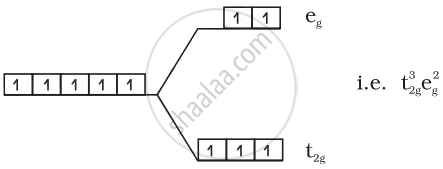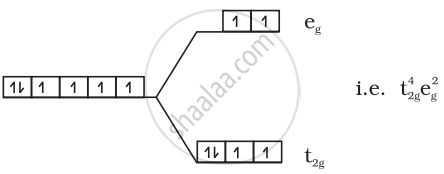Advertisements
Advertisements
Question
Using crystal field theory, draw energy level diagram, write electronic configuration of the central metal atom/ion and determine the magnetic moment value in the following:
\[\ce{[FeF6]^{3-}, [Fe(H2O)6]^{2+}, [Fe(CN)6]^{4-}}\]
Solution
(1) \[\ce{FeF^{3-}6}\]:

\[\ce{Fe^{3+} = 3d^5}\]
Number of unpaired electrons = 5
Magnetic moment = `sqrt(5(5 + 2))` = 5.92 BM
(2) \[\ce{[Fe(H2O)6]^{2+}}\]:

\[\ce{Fe^{2+} = 3d^6}\]
Number of unpaired electrons = 4
Magnetic moment = `sqrt(4(4 + 2))` = 4.9 BM
(3) \[\ce{[Fe(CN)6]^{4-}}\]:
\[\ce{Fe^{2+} = 3d^6}\]
Since CN– is a strong field ligand all the electrons get paired.

No unpaired electrons so diamagnetic.
APPEARS IN
RELATED QUESTIONS
Why are low spin tetrahedral complexes rarely observed?
Draw the structures of the following :
(1) XeF6
(2) IF7
The colour of the coordination compounds depends on the crystal field splitting. What will be the correct order of absorption of wavelength of light in the visible region, for the complexes, \[\ce{[Co(NH3)6]^{3+}}\], \[\ce{[Co(CN)6]^{3-}}\], \[\ce{[Co(H2O)6]^{3+}}\]
An aqueous pink solution of cobalt (II) chloride changes to deep blue on addition of excess of HCl. This is because:
(i) \[\ce{[Co(H2O)6]^{2+}}\] is transformed into \[\ce{[CoCl6]}^{4-}\]
(ii) \[\ce{[Co(H2O)6]^{2+}}\] is transformed into \[\ce{[CoCl4]}^{2-}\]
(iii) tetrahedral complexes have smaller crystal field splitting than octahedral complexes.
(iv) tetrahedral complexes have larger crystal field splitting than octahedral complex.
Arrange following complex ions in increasing order of crystal field splitting energy (∆O):
\[\ce{[Cr(Cl)6]^{3-}, [Cr(CN)6]^{3-}, [Cr(NH3)6]^{3+}}\].
Match the complex ions given in Column I with the hybridisation and number of unpaired electrons given in Column II and assign the correct code:
| Column I (Complex ion) | Column II (Hybridisation, number of unpaired electrons) |
| A. \[\ce{[Cr(H2O)6]^{3+}}\] | 1. dsp2, 1 |
| B. \[\ce{[Co(CN)4]^{2-}}\] | 2. sp3d2, 5 |
| C. \[\ce{[Ni(NH3)6]^{2+}}\] | 3. d2sp3, 3 |
| D. \[\ce{[MnF6]^{4-}}\] | 4. sp3, 4 |
| 5. sp3d2, 2 |
Considering crystal field theory, strong-field ligands such as CN–:
The correct order of increasing crystal field strength in following series:
The magnitude of CFSE depends upon ______
For octahedral Mn(II) and tetrahedral Ni(II) complexes, consider the following statements:
(i) Both the complexes can be high spin.
(ii) Ni(II) complex can very rarely below spin.
(iii) With strong field Ligands, Mn(II) complexes can be low spin.
(iv) Aqueous solution of Mn (II) ions is yellow in colour.
The correct statements are:
